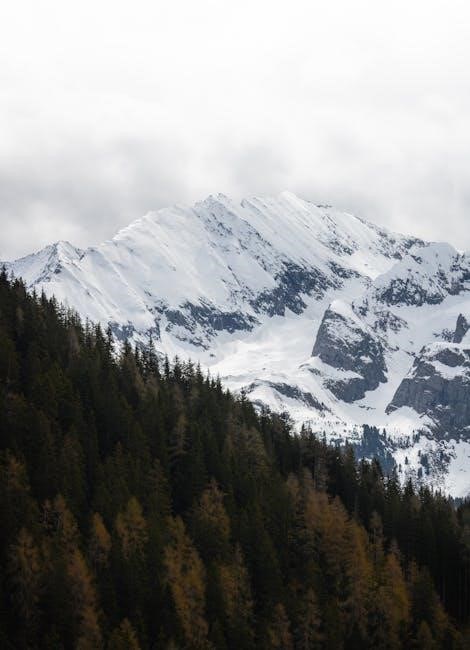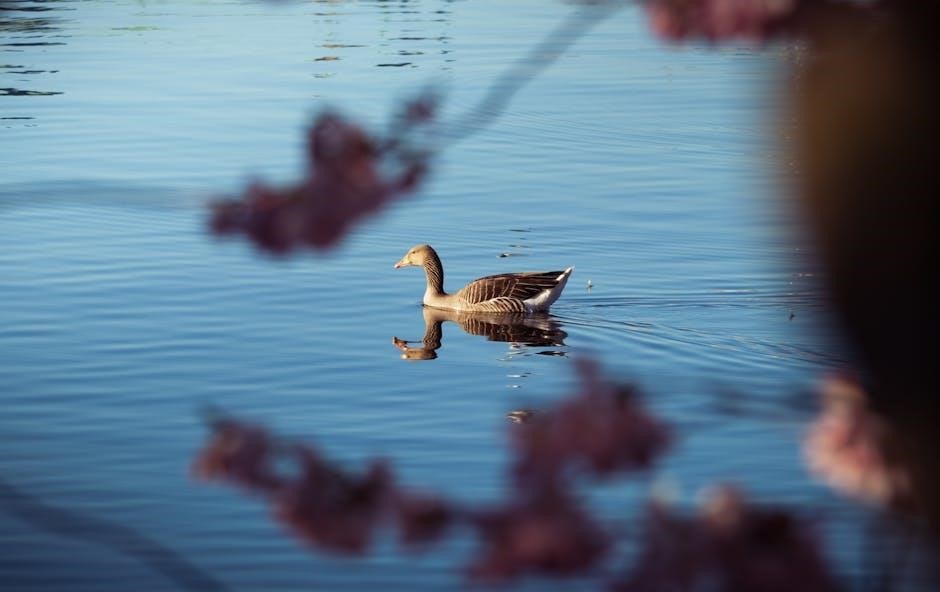Discover the world of foraging with The Forager’s Guide to Wild Foods, offering 400 edible plants, vibrant images, and expert tips for sustainable, ethical foraging adventures.
What is Foraging?
Foraging is the act of searching for and gathering wild foods in their natural environments. It involves identifying edible plants, fruits, nuts, and mushrooms, often requiring knowledge of ecosystems and seasonal availability. The Forager’s Guide to Wild Foods emphasizes sustainable practices, ensuring the preservation of nature while harvesting. Foraging is not just about finding free food; it’s a mindful connection with the environment, promoting health, economic savings, and emergency preparedness. This practice fosters a deeper appreciation for nature’s bounty and encourages ethical, responsible interaction with the wild.
Benefits of Foraging and Why You Should Try It
Foraging offers numerous benefits, including access to fresh, nutrient-rich foods that enhance health and longevity. It promotes sustainability by utilizing renewable resources and fosters a deeper connection with nature. Foraging can also be a cost-effective alternative to traditional grocery shopping, providing free food while encouraging outdoor exploration. Additionally, it serves as a valuable survival skill, offering a reliable food source in emergencies. The Forager’s Guide to Wild Foods highlights these advantages, making it easier for beginners to embrace this rewarding practice and enjoy the culinary and environmental rewards it provides.
Identifying Wild Foods
Foraging involves safely identifying edible plants using trusted guides like The Forager’s Guide to Wild Foods, which offers detailed descriptions and high-quality images for accurate recognition.
The Golden Rule: Absolute Identification of Plants
The golden rule of foraging is absolute identification of plants. This principle, emphasized in The Forager’s Guide to Wild Foods, ensures safety and avoids poisoning. Nicole Apelian’s guide provides detailed descriptions and high-quality images to help users confidently identify edible plants. Misidentification can lead to serious harm, making this rule non-negotiable for all foragers. The guide underscores the importance of certainty, encouraging consultation of multiple sources before consumption. This rule applies to both beginners and experienced foragers, as mistakes can occur regardless of skill level. By adhering to this rule, foragers not only protect themselves but also promote sustainable harvesting practices.
High-Quality Pictures for Accurate Identification
High-quality pictures are essential for accurate plant identification, as highlighted in The Forager’s Guide to Wild Foods. Nicole Apelian’s guide features vibrant, color images of each plant, ensuring clarity and precision. These visuals aid in distinguishing edible species from harmful lookalikes, reducing the risk of misidentification. The guide emphasizes the importance of clear imagery for safety and confidence. Printed on photo paper, these images provide unparalleled detail, making them indispensable for both beginners and experienced foragers. This visual approach ensures that users can identify plants with certainty, fostering a safe and enjoyable foraging experience. The guide’s commitment to high-quality visuals underscores its reliability as a trusted resource.

Safety and Sustainability in Foraging
The Forager’s Guide to Wild Foods prioritizes safety and sustainability, offering expert advice on avoiding hazards and harvesting responsibly to preserve ecosystems for future generations.
Hazards of Foraging and How to Avoid Them
Foraging poses risks like plant misidentification, which can be dangerous or even fatal. To avoid hazards, always follow the golden rule: absolute identification of plants using reliable guides. Be cautious of lookalike species and avoid plants growing in polluted areas. Over-harvesting can harm ecosystems, so practice sustainable foraging by only taking what’s needed. The Forager’s Guide to Wild Foods provides high-quality images and expert tips to ensure safe and responsible foraging practices, helping you navigate potential dangers while enjoying nature’s bounty.
Sustainable Foraging Practices
Sustainable foraging ensures harmony with nature by avoiding over-harvesting and preserving ecosystems. The Forager’s Guide to Wild Foods emphasizes ethical practices, such as leaving enough plants to regenerate and not damaging habitats. It promotes responsible harvesting methods to prevent resource depletion. By following these guidelines, foragers can enjoy wild foods while maintaining environmental balance and ensuring future generations can also benefit from nature’s bounty.
The Forager’s Toolkit
A reliable forager’s toolkit includes essential items like a field guide, sturdy basket, gloves, and a knife for harvesting wild foods efficiently and safely.
Essential Tools for Foraging
A successful foraging excursion requires the right tools. Start with a reliable field guide for accurate plant identification. A sturdy basket or bag is essential for carrying your finds. Wear durable gloves to protect your hands while handling plants. A sharp knife or pruning tool is handy for harvesting. Consider a magnifying glass for closer inspections. Bring a container for water and snacks to keep you energized. Lastly, always carry a map or GPS device to navigate safely. These tools ensure efficiency, safety, and a more enjoyable foraging experience.
How to Prepare for a Foraging Excursion
Preparing for a foraging excursion involves careful planning and organization. Start by researching the season’s available wild foods in your area. Gather essential tools like a basket, gloves, and a knife for harvesting. Dress appropriately for the terrain, wearing sturdy shoes and weather-appropriate clothing. Bring a field guide or downloaded PDF for quick plant identification. Stay hydrated and energized with water and snacks. Familiarize yourself with local regulations and ethical practices to ensure sustainable foraging. Finally, check the weather and plan your route to maximize your foraging experience while respecting nature and its bounty.

Ethical Guidelines for Foraging
Practice sustainable foraging by harvesting responsibly and avoiding over-harvesting. Always respect private property, obtain permission when needed, and leave the environment undisturbed. Give back by planting or cleaning up, ensuring future abundance.
Rules of Engagement for Ethical Foraging
Ethical foraging begins with respecting nature and communities. Always obtain permission to forage on private land and avoid protected areas. Harvest sustainably, leaving enough for ecosystems and future foragers; Be mindful of local regulations and ensure no harm to the environment. Educate yourself on plant identification to avoid mistakes. Share knowledge responsibly and promote conservation. By following these guidelines, you contribute to preserving wild foods and fostering a deeper connection with nature. Remember, ethical foraging is about balance and respect for the land and its resources.
How to Ask Permission to Forage on Private Land
When foraging on private land, always seek permission from the landowner. Approach respectfully, explaining your intentions and willingness to follow their rules. Offer to share harvested items or assist with tasks in exchange for access; Be clear about the areas you plan to forage and assure them of your commitment to sustainability. Many guides, like The Forager’s Guide to Wild Foods, emphasize the importance of ethical practices. By obtaining permission, you build trust and ensure responsible foraging, fostering positive relationships with landowners while enjoying nature’s bounty responsibly;
Mapping Wild Foods in Your Area
Explore your region’s wild foods with detailed maps and identification tools. Create personalized maps to track seasonal availability and sustainable harvesting spots sustainably.
How to Identify and Locate Wild Foods Near You
Identifying wild foods near you starts with understanding local flora and using high-quality visual guides. The Forager’s Guide to Wild Foods provides detailed descriptions and color images to ensure accurate identification. Seasonal tracking is key—know when plants are in bloom or fruit. Use maps and community resources to locate abundant areas. Always prioritize safety by avoiding polluted zones and unknown species. Testimonials highlight how this guide empowers users to confidently locate edible plants nearby, fostering a deeper connection with nature and a sustainable food supply. It’s a practical tool for both beginners and experienced foragers seeking fresh, healthy options.
Seasonal Availability of Wild Foods
Wild foods vary with the seasons, offering fresh options year-round. Spring brings wild greens, summer ripe berries, fall yields nuts, and winter hides edible roots. The Forager’s Guide to Wild Foods provides detailed maps and calendars to track availability. It highlights regional differences, ensuring users know what to forage in their area. Seasonal awareness is key to sustainable practices, avoiding over-harvesting. Testimonials reveal how this guide helps foragers adapt to nature’s cycles, ensuring a steady supply of wild foods while respecting ecosystems. It’s a vital resource for mastering the rhythms of foraging.

Resources and Guides
The Forager’s Guide to Wild Foods offers a comprehensive resource with 400 plants, high-quality images, and essential tips, making it a must-have for both beginners and experienced foragers.
The Forager’s Guide to Wild Foods: Key Features
The Forager’s Guide to Wild Foods is a comprehensive resource featuring over 400 edible plants, each detailed with high-quality color images for accurate identification. It emphasizes sustainable practices, ensuring nature’s resources remain abundant. The guide covers essential tools, ethical foraging guidelines, and tips for mapping wild foods in your area. Seasonal availability charts help users locate plants year-round. Designed for both beginners and experienced foragers, it also includes survival tips and regional plant variations. Available as a downloadable PDF, it’s printable on standard paper, making it a versatile and indispensable companion for any foraging journey.
Additional Resources for Beginners
Beginners can enhance their foraging journey with complementary resources like Grinnell University’s free 76-page PDF guide on wild edible plants. Nicole Apelian’s guide offers detailed plant profiles and survival tips. Additionally, downloadable tools such as field guides and seasonal availability charts provide practical support. These resources emphasize sustainable practices and ethical foraging, ensuring a safe and enriching experience. They also include high-quality images and regional plant variations, making them invaluable for learners. With these materials, newcomers can confidently explore the world of wild foods, equipped with the knowledge to identify, harvest, and enjoy nature’s bounty responsibly.

Testimonials and Reviews
Users praise The Forager’s Guide for its clarity and practicality. One reader shares, “A fantastic creation—easy to use and brilliantly designed for quick reference.”
How The Forager’s Guide Has Empowered Foragers
The Forager’s Guide to Wild Foods has transformed countless lives by reconnecting people with nature and fostering self-sufficiency. Readers highlight its detailed plant profiles and vibrant images, which simplify identification. Many credit the guide for enhancing their culinary skills and promoting a healthier lifestyle. One testimonial shares, “It’s like having a 24/7 food store at my fingertips!” The guide’s emphasis on ethical practices ensures sustainable foraging, empowering users to harvest responsibly while preserving ecosystems. Its accessible format has made foraging accessible to both beginners and experienced enthusiasts, creating a global community of nature-conscious individuals.
Success Stories from Experienced Foragers
Experienced foragers praise The Forager’s Guide to Wild Foods for its transformative impact. One enthusiast shared how the guide’s detailed profiles and vibrant images helped them confidently identify and harvest wild foods. Another highlighted its portability and ease of use, calling it a “handy reference for quick access to essential information.” Many credit the guide for deepening their connection to nature and enhancing their culinary skills. Testimonials reveal how the guide has become an indispensable tool, empowering foragers to explore and enjoy the bounty of wild foods responsibly and sustainably. Its practical insights have elevated foraging experiences worldwide.
